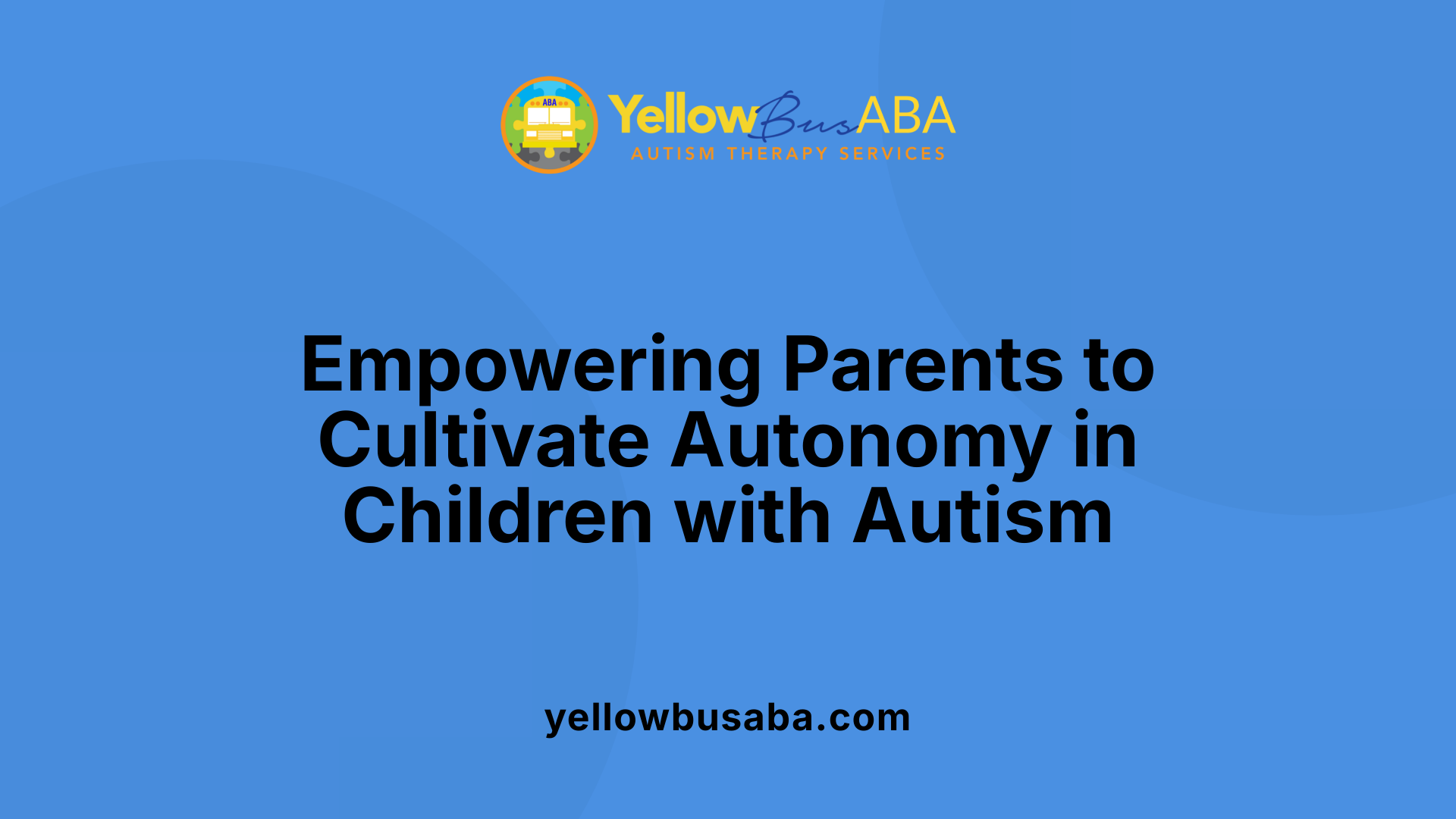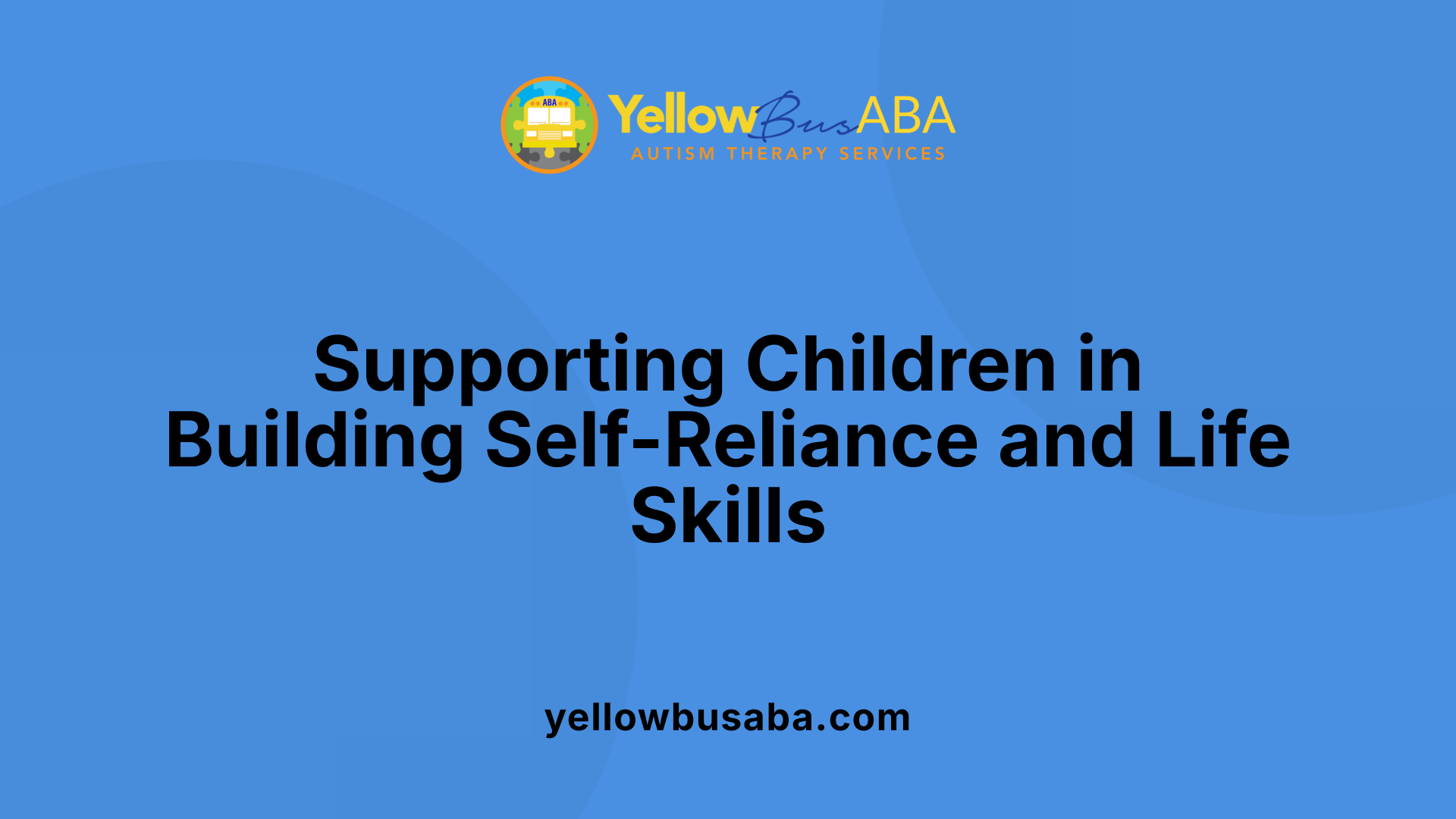How Parent Training Helps Foster Independence in Daily Activities
August 8, 2025
Empowering Families for Lasting Change

Understanding the Power of Parent Training in Autism Support
Parent training within ABA therapy is a cornerstone of empowering families of children with autism to support their child's development of independence and adaptive skills. This comprehensive approach equips caregivers with practical tools, evidence-based strategies, and personalized coaching to foster positive behaviors, manage challenges, and promote self-reliance during everyday routines. In this article, we explore how parent training enhances independence in daily activities, the techniques involved, and its critical role within ABA therapy.
The Purpose and Goals of Parent Management Training

What is the purpose of parent management training and what are its goals?
Parent management training (PMT) is a specialized approach designed to equip parents with effective strategies to handle and alter challenging behaviors in children. The core aim of PMT is to foster positive behaviors by teaching parents how to use reinforcement, set clear boundaries, and consistently apply consequences.
One of the main goals is to improve the overall parent-child relationship. When parents learn to manage behaviors constructively, the family environment becomes more harmonious. This also aids in strengthening communication and nurturing emotional development.
PMT emphasizes reducing behaviors such as aggression, defiance, hyperactivity, and tantrums. This is achieved through a focus on behavioral techniques that promote cooperation and respect.
Additionally, the training aims to enhance family functioning by empowering parents to implement strategies confidently across various settings, including at home, school, and community environments. It helps parents better navigate everyday challenges, making daily routines more manageable.
The program typically offers a structured, short-term, and personalized plan tailored to each family’s unique needs. Practical skills taught include praising appropriate behaviors, ignoring minor misbehaviors, and applying consistent consequences.
Ultimately, the goal is to support children’s social, emotional, and behavioral growth while reducing stress and frustration within the family. Through evidence-based techniques, parent training empowers families to create a supportive environment where children can thrive and develop essential life skills.
This approach not only benefits children but also boosts parental confidence, reduces behavioral issues, and fosters healthier family dynamics overall.
Core Techniques and Strategies in Parent Training
What techniques and strategies are used in parent training to promote independence?
Parent training focuses on empowering caregivers with proven ABA methods to foster independence in children. Essential techniques include reinforcement, prompting, shaping, and prompt fading, all designed to encourage children to acquire new skills and become more autonomous.
Reinforcement involves rewarding positive behaviors to increase their occurrence. Prompting provides cues or hints to help children perform desired actions, while shaping gradually teaches new skills by reinforcing successive approximations of the target behavior. Prompt fading reduces reliance on prompts over time, fostering independent performance.
Creating structured routines and using visual aids support consistent learning. Visual schedules, picture cards, and step-by-step guides help children understand expectations and follow through on activities like dressing, brushing teeth, or unpacking their backpacks.
Behavioral Skills Training (BST) is a central strategy in parent coaching. It typically includes instruction, modeling, role-playing, and feedback, allowing parents to practice and perfect their skills in real-life situations. Data collection is integral, enabling families and professionals to monitor progress and adjust strategies accordingly.
Together, these techniques help children gain independence in daily activities and reduce reliance on adult assistance. They also promote confidence, perseverance, and problem-solving skills, which are vital for long-term growth.
| Technique/Strategy | Description | How It Promotes Independence |
|---|---|---|
| Reinforcement | Reward for desired behaviors | Encourages repeated independent actions |
| Prompting & fading | Cues to assist and gradual removal of prompts | Builds confidence to perform tasks solo |
| Visual aids | Pictures and schedules to guide behavior | Provides clear understanding and structure |
| BST (Behavioral Skills Training) | Training through instruction, modeling, and practice | Enhances parental implementation skills |
| Data collection | Tracking progress and behaviors | Identifies effective strategies and areas for improvement |
How can parents apply these strategies during daily routines?
Parents can embed these techniques into common routines like mealtime, play, or transitions. For example, using visual cues during bedtime routines or giving choices during dressing enhances independence.
Applying positive reinforcement consistently, offering simple prompts, and gradually fading assistance help children learn and practice skills on their own.
By engaging children in problem-solving and offering opportunities for decision-making within safe boundaries, parents support their child's development of autonomy.
This systematic approach, combined with ongoing support from behavior analysts, ensures that children develop skills that improve their independence and everyday functioning.
Integrating ABA Strategies into Daily Routines

How can routines like mealtime, bath time, play, shopping, and bedtime be used as moments for learning?
Daily routines such as mealtime, bath time, play, shopping trips, and bedtime are excellent opportunities to embed behavior interventions learned through ABA. These everyday activities create natural contexts where children can develop communication, social, and self-help skills.
During mealtime, for example, parents can encourage children to request food, help set the table, or practice sitting calmly. Bath time can be used to teach hygiene routines, promote self-dressing, or practice following multi-step instructions.
Playing together allows for joint attention, turn-taking, and imitation activities that reinforce social skills. Grocery shopping can be an opportunity for children to identify and select items, practice making choices, and follow multi-step directions. Bedtime routines, involving calming activities and self-regulation strategies, support emotional regulation and independence in nightly preparations.
Incorporating structured learning into these routines transforms everyday moments into purposeful teaching opportunities that foster development and reduce behavioral challenges.
How does parent training support independence development in children with autism?
Parent training plays a vital role in promoting independence for children with autism. By equipping caregivers with specific strategies and skills, parents can guide their children through daily activities that foster self-help and functional living.
Through systematic teaching, parents learn to break tasks into manageable steps, model desired behaviors, and reinforce progress with praise and rewards. For example, parents can teach children to dress themselves, manage personal hygiene, or make simple choices.
Training also emphasizes the importance of giving children opportunities to solve problems and make decisions within safe boundaries. This approach helps build a child's confidence, perseverance, and autonomy.
Moreover, parent-mediated interventions enable children to practice skills across different environments, promoting consistency and generalization. As a result, children become more independent and capable of managing daily routines with less adult support.
How are ABA principles such as reinforcement, prompting, and generalization used at home?
ABA principles are foundational in parent training, guiding parents to effectively support their child's development.
Reinforcement involves rewarding desired behaviors to increase their occurrence. For instance, praising a child for completing a task encourages repetition.
Prompting and fading are used to guide children toward the correct response and gradually reduce assistance as they learn.
Modeling demonstrates the behaviors parents want children to imitate, such as handwashing or greeting others.
Generalization ensures that skills learned in one setting or with one person transfer to others. Parents are taught to apply strategies across different routines, environments, and with various people to reinforce learning.
Using these techniques consistently at home creates a supportive environment where children can acquire, practice, and sustain new skills, promoting independence and reducing behavioral issues.
| Strategy | Application Examples | Benefits |
|---|---|---|
| Reinforcement | Praising, giving tokens, or preferred activities | Increases likelihood of desired behaviors |
| Prompting & fading | Verbal hints, physical guidance, gradually removing cues | Facilitates skill acquisition |
| Modeling | Demonstrating tasks like dressing or brushing teeth | Enhances imitation and learning |
| Generalization | Practicing skills in different settings and with various people | Ensures skills are maintained across contexts |
This integrated approach helps parents feel confident in managing their child's development and addressing everyday challenges effectively.
Applying ABA Principles for Skill Development

What techniques and strategies are used in parent training to promote independence?
Parent training in ABA emphasizes practical, evidence-based techniques that enable caregivers to foster their child's independence. Central to this approach are strategies like reinforcement, prompting, fading, and modeling.
Reinforcement involves rewarding desired behaviors to increase their occurrence. For example, praising a child for dressing independently encourages repeating this behavior. Prompting provides hints or cues to guide the child toward the correct action, which are gradually faded to promote independence. Shaping involves reinforcing successive approximations to the desired skill, gradually building the child's competence.
In addition to these, visual aids and structured routines help children understand expectations and sequence tasks. Parents are trained to create simple, clear instructions broken into manageable steps, making tasks less overwhelming.
Behavior Skills Training (BST) and role-playing enable parents to practice these techniques in a supportive setting. Ongoing coaching and feedback ensure consistent application. Data collection on the child's progress is vital, allowing caregivers and therapists to monitor improvements and adjust strategies as needed.
Encouraging problem-solving through choices and decision-making fosters autonomy. Activities like helping with chores or participating in unstructured play can reinforce independence and build confidence.
A cornerstone of this process is supporting communication skills, which can include teaching children to express needs or make choices, further enhancing their ability to function independently.
By systematically applying these techniques, parents can help their children develop critical life skills, from toileting and dressing to problem-solving and decision-making. The process creates a consistent environment where children learn to manage daily tasks independently, reducing reliance on parental guidance over time.
Overall, parent training incorporating these ABA strategies empowers families to promote lasting skills, foster autonomy, and improve overall developmental outcomes for children with autism.
Parent Training’s Role in Enhancing Children’s Autonomy

How does parent training support independence development in children with autism?
Parent training plays a crucial role in helping children with autism develop independence. It equips caregivers with specific strategies to promote self-help, communication, and adaptive skills across different settings.
Through targeted teaching of daily living activities such as dressing, brushing teeth, and unpacking backpacks, parents learn to systematically guide their children toward completing tasks independently. They are trained to reinforce progress using positive feedback, modeling behaviors, and providing choices, which encourages children to take responsibility for their actions.
Importantly, parent training emphasizes practicing these skills in natural, everyday environments like mealtime, playgrounds, and grocery stores. This approach supports generalization, ensuring children can apply learned skills across various situations, leading to long-lasting independence.
Programs often focus on helping parents recognize opportunities for skill development and use reinforcement techniques effectively. For example, praising a child for independently washing hands or encouraging problem-solving during playtime nurtures persistence and confidence.
Overall, well-structured parent training empowers families to foster independence. This not only helps children gain more control over their routines but also reduces their dependence on constant adult support, paving the way for greater self-esteem and participation in daily life.
The Impact of Parent-Professional Collaboration and Evidence-Based Practices
What role does parent training play within ABA therapy in supporting children’s autonomy?
Parent training is a fundamental component of Applied Behavior Analysis (ABA) therapy that directly promotes a child's independence and self-sufficiency. It involves equipping parents with practical skills and strategies to reinforce positive behaviors, implement behavioral interventions, and support skill development at home.
Through personalized coaching and clear instruction, parents learn to utilize techniques such as reinforcement, prompting, shaping, and modeling. These tools enable them to create consistent routines and embed therapeutic strategies seamlessly into daily life. For example, during routines like dressing, brushing teeth, or choosing activities, parents can apply visual aids, give children simple choices, and praise efforts to encourage autonomous behavior.
This training empowers parents to extend therapy beyond formal sessions, promoting the generalization of skills in various settings such as at school, during social interactions, and in community environments. As a result, children develop greater independence in activities like self-care, following instructions, and problem-solving.
Furthermore, parent training boosts parental confidence and strengthens family relationships by fostering a supportive and collaborative approach to behavior management. It also helps reduce parental stress by providing effective tools to handle challenging behaviors like tantrums or resistance to transitions.
By fostering consistent, positive reinforcement and encouraging children to take initiative, parent training significantly enhances a child's ability to function independently. This active involvement not only reinforces progress made during therapy but also ensures that skills are maintained and generalized, ultimately leading to increased autonomy and improved quality of life for children with autism.
In sum, parent training within ABA supports children’s autonomy by transforming parents into effective facilitators of their child's development, ensuring that therapeutic gains are sustained across all areas of daily life.
Fostering Self-Reliance and Practical Life Skills

How can parents and caregivers help children develop self-reliance and independence in daily routines?
To promote independence, parents and caregivers should start by providing children with simple, clear responsibilities. Establishing consistent routines helps children understand what is expected of them and builds a sense of accountability. For example, assigning tasks like setting the table, choosing their clothes, or packing their backpack encourages ownership of their daily activities.
Modeling independent behaviors is a highly effective strategy. Adults demonstrating time management, problem-solving, and decision-making serve as tangible examples for children to imitate. When children see their caregivers handling challenges confidently, they learn how to navigate similar situations.
Encouraging children to take on age-appropriate chores, manage their belongings, and make choices fosters their confidence. Giving children opportunities to explore, like selecting their clothes or preparing simple snacks, helps develop decision-making skills and promotes resilience.
Creating a safe environment for trial and error is crucial. When children are allowed to learn from mistakes and receive positive feedback, they build emotional strength and perseverance. Celebrating successes and calmly guiding them through setbacks nurtures their self-esteem.
Open communication plays a vital role. Listening to their opinions, respecting their autonomy, and supporting their interests motivate children to take initiative. These practices collectively contribute to developing their practical skills, independence, and confidence to handle challenges independently.
Building a Foundation for Lifelong Independence
Empowering parents and caregivers through systematic training and evidence-based strategies is essential for fostering independence in children with autism. When parents understand and implement ABA principles, they create nurturing environments that reinforce skills across contexts, from everyday routines to social interactions. The collaboration between families and professionals not only enhances a child's developmental trajectory but also strengthens family bonds and boosts parental confidence. By promoting self-help, decision-making, and resilience, parent training plays a pivotal role in equipping children with autism to become more autonomous and capable individuals, setting the stage for lifelong success.
References
- Parent Training in ABA: Turn Everyday Moments into Learning
- ABA Parent Training: Tips and Strategies for Parents
- Parent Training with Solstice: Empowering Families to Support ...
- The Role of Parent Training in ABA /Aim Higher ABA
- How to Build Independence in Preschoolers - Child Mind Institute
- Promoting a Child's Independence Within Daily Routines
- ABA Parent Training: Tips and Strategies for Parents
- 10 Steps for Effective ABA Parent Training - Beyond Infinity ABA
- Behavioral Parent Training: Important Tips and Strategies | Regis






